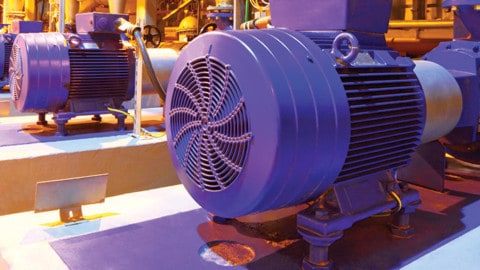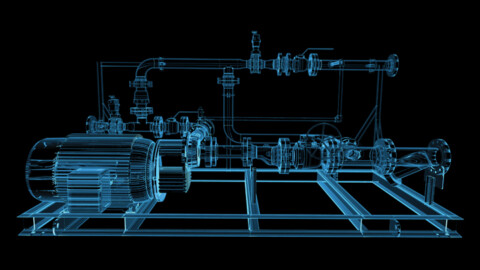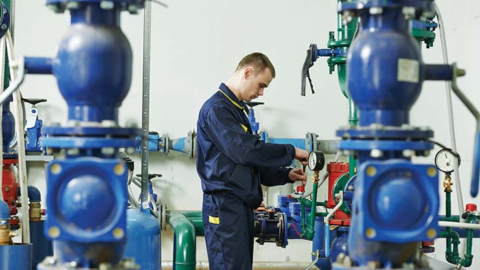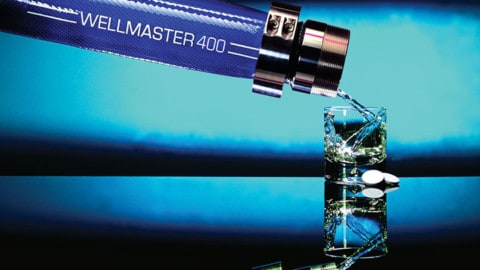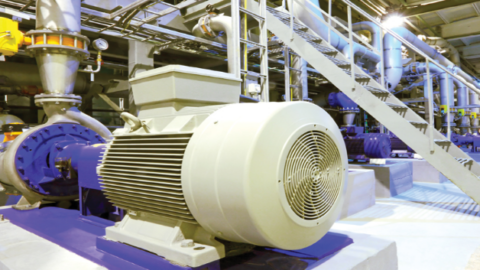By Heinz P. Bloch, PE, Process Machinery Consulting, and Richard Smith, Oil & Gas Development Director at AESSEAL
When installed and operated correctly, general purpose steam turbines are reliable. However, there are opportunities available to further improve reliability, reduce the risk of failures and save money by upgrading to advanced bearing housing protector seals. In this first of a two part series, Heinz P. Bloch and Richard Smith look at cost-saving opportunities for general purpose steam turbines.
It is not unusual for large oil refineries to have 160 general purpose (GP) steam turbines installed at a major site. As long as these machines are connected to a steam supply, preventing the often steam-inundated environment (see Figure 1) from entering the bearing housing is of great importance to reliability-focused refineries, fertiliser producers and petrochemical plants.
Steam intrusion often occurs simply because the steam gland and bearing housing are adjacent to each other (see Figure 2).
Fortunately, modern bearing protector seals are readily available for GP steam turbines.
If well designed, these protector seals can virtually eliminate premature bearing failure. Upgrading to an advanced bearing housing seal retrofit arrangement (Figure 3) is, therefore, well worth considering.
Thoroughly engineered bearing housing protector seals achieve effective contaminant and vapor exclusion by incorporating an axially-moving O-ring. They are easily cost-justified and greatly contribute to run-length extension.
Return-on-investment and projected payback
Return-on-investment (ROI) studies and related cost assessments indicate that major refineries may have opportunities to capture steam turbine-related corporate-wide maintenance savings in excess of $3,000,000 annually.
These experience-backed savings projections can be examined more closely and deserve to be compared to what it costs to maintain small steam turbines with their ‘as originally supplied’ components.
If available, readers can draw on their own in-plant experience and cost data; alternatively, they are encouraged to study and use our projected savings. Note that we have occasionally been asked where oil refineries have published their failure details and related maintenance cost records.

Figure 1. Steam leakage surrounds this typical GP (General Purpose) Steam Turbine.
History provides the answer; it shows that entities that perform below par will not broadcast their poor performance to the rest of the world. Similarly, the few who stand out and excel will claim Competitive Advantage and are thus equally reluctant to communicate useful details on how they became Best-of-Class (BoC) performers.
This is why we are ready to offer our own experience-backed numbers.
Where savings come from
Maintenance savings and steam turbine run-length extension are in great part attributable to advanced bearing housing protection components (Figure 3).
We have simplified our study results by expressing savings in different ways.
Among these are time elapsed for benefits to equal investment, often called ‘payback’. Another study examines the benefit-to-cost ratio for advanced bearing protector components that can be fitted to new and also to existing steam turbines.
In particular, plants will find it easy to pursue such retrofitting as part of a structured plant-wide maintenance cost reduction and equipment availability improvement program.

Figure 2. Spots marked ‘O’ are bearing locations. Gland is adjacent to bearing.
Working with a reasonably accurate total investment of $1,500 per GP steam turbine (which includes installing protective seals at the three locations identified in Figure3), we often obtain break even or payback within less than six months.
We found that, although usually aimed at preventing bearing distress, upgrading to advanced bearing housing protector seals also captures safety benefits. Steam turbine fires can result from steam leaking into the bearing housing. As the steam then condenses, some of the oil is forced out as leakage.
Because the upgrade prevents steam leaking into the bearing housing, the imputed value of fire avoidance is a cost saving that deserves to be included in cost justification calculations.
Some closely-guarded ‘company confidential’, albeit pessimistic, reports assume one $3,000,000 fire per 200 repair interventions on small steam turbines in low-performing oil refineries.
True optimists assume one fire per 2,000 distress or repair events — the number we will actually use later.
A large corporation with 10 or 12 oil refineries may have a fleet of 1,600 small steam turbines installed. For an individual facility with 160 small steam turbines, 16 repair interventions per year would represent an MTBF of 160/16 = 10 years, which is a slightly above industry-average mean-time-between-failure.
Understanding and estimating the cost of current practices

Figure 3. Location and configurational details of a well-proven steam turbine bearing housing protector seal. Note the large cross-section O-ring which seals against a static seat if the shaft is stopped and provides an axial micro-gap with shaft operating.
Before discussing cost savings achieved with advanced bearing protection in GP steam turbines, recall that bearing failure avoidance through the conscientious implementation of precautionary maintenance routines is possible, but will cost money.
‘Saving’ such monetary outlays by doing nothing will be even more risky. ‘Doing nothing’ causes frequent failures; it incurs high repair expenditures, reduces equipment unavailability and causes safety incidents. We can be certain that ‘doing nothing’ neither enhances employee morale nor company image.
Not unexpectedly, a few facilities that report high steam turbine reliability have achieved low failure rates by spending more money for preventive maintenance. Recall that lubricating oil is contaminated by steam blowing past the carbon rings in the shaft glands (Figure 2).
The contaminated oil requires periodic discarding and must be replaced by fresh, clean oil. As a precautionary activity, water must be drained off in an effort to extend bearing life and machine reliability.
However, by the time free water collects and is visible in a sampling line or sight glass, dissolved water will exist and often cause additives depletion through a process called partitioning.
The additives partition themselves between the oil and water phase in proportions that largely depend on their relative solubilities. When free water is removed from the oil by gravity, coalescing or centrifuging, these additives are lost.
The loss deprives the oil of the protection normally given by anti-rust and anti-oxidant inhibitors. Moreover, water will combine with airborne dust to form sludge*.
It follows that scenarios whereby free water is periodically removed manually are technically inferior; merely draining off free water is not found among the practices of reliability-focused Best-of-Class facilities.
Sound water removal strategies involve mechanical equipment and include vacuum dehydration, coalescing and air sparging. All of these strategies cost more money than preventing water intrusion through the use of modern bearing housing protector seals.
Taking into account the above, some facilities schedule and carry out monthly precautionary lubrication interventions. As a result, labour costs are incurred to visit the machine for regular oil sampling, oil replacement, and waste oil disposal.
Corrective action work orders are then required for the work activities to be initiated and carried out. Disposal costs of $4.00 (or more) are generally associated with each gallon of contaminated oil. Writing and processing a work order is typically assumed to cost $400.
It goes without saying that high reliability is also essential for machines in hot standby service, or serving as ‘cold’ (blocked-in, fully installed) spares. In all cases, steam turbine repairs can consume considerable workshop man-hours and associated money outlays.
To restate the obvious: by simply doing nothing is a risky alternative to precautionary intervention; the ‘do nothing’ alternative is, therefore, never considered by reliability-focused and responsible Best-of-Class (BoC) users.
Reliability-focused users are thus left with either a precautionary intervention option that costs money over the life of the plant, or upgrade steps that are limited to the one-time cost of bearing housing protector seals with a demonstrated life that averages in excess of 10 years.
That said, BoCs take note that the component technology in current use has changed little in 100 years**. But a measure of uniformity and reliability upgrading exist in certain industry
standards.
The machines at issue are almost always purchased by invoking the provisions of API-611, the American Petroleum Institute’s Standard for General Purpose Steam Turbines in the Petroleum, Chemical and Gas Industries3. In this instance, clauses that apply to bearing housing seals are of interest to us.
The applicable API-611 standard*** states:
6.10.4.2.1 Bearing housings shall be equipped with replaceable labyrinth-style end seals and deflectors where the shaft passes through the housing; lip-type seals shall not be used. The seals and deflectors shall be made of non-sparking materials.
The design of the seals and deflectors shall effectively retain oil in the housing and prevent entry of steam, condensation and foreign material into the housing.
6.10.4.2.1 (Option) If specified, bearing isolation seals providing a positive tight seal to prevent the ingress of atmospheric contaminants shall be supplied.
In the next part of this series Heinz P. Bloch and Richard Smith discuss the advantages of upgrading to new technologies, and the paybacks and expected performance for different upgrade situations.
Heinz P. Bloch resides in Westminster, Colorado. His professional career commenced in 1962 and included long-term assignments as Exxcon Chemical’s Regional Machinery Specialist for the US.
He has authored or co-written close to 700 publications, among them 20 comprehensive books on practical machinery management, failure analysis, failure avoidance, compressors, steam turbines, pumps, oil mist lubrication and practical lubrication for industry.
Mr Bloch holds B.S. and M.S. degrees (cum laude) in Mechanical Engineering. He is an ASME Life Fellow and was awarded lifetime registration as a Professional Engineer in New Jersey.
Richard Smith served as a Product and Services Manager with international responsibilities for AESSEAL, Inc, located in Rotherham, UK, and Rockford, TN.
His 35-year experience is largely concentrated in the development of advanced sealing products for fluid machinery in the petrochemical and petroleum refining industries.
*Bloch, Heinz P. and Kenneth Bannister, ‘Practical Lubrication for Industrial Facilities’, 2017, (3rd Edition); The Fairmont Press, Lilburn, GA, PP. 436, 437; ISBN 0-88173-761-5
**Martin Harold M, ‘Labyrinth Packings’, Engineering, vol 85, 1908
***API-611 General Purpose Steam Turbines for Petroleum, Chemical and Gas Industries, May 2008 (5th Edition), American Petroleum Institute, Washington DC







